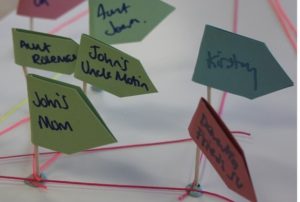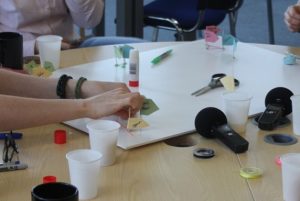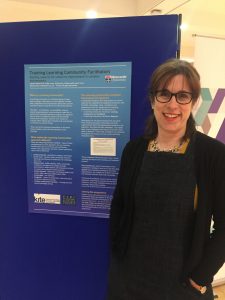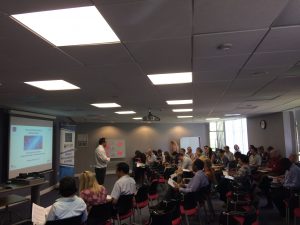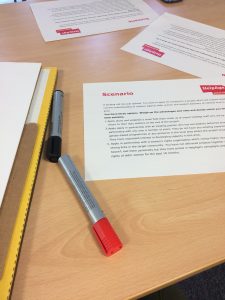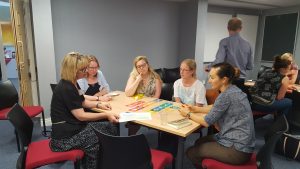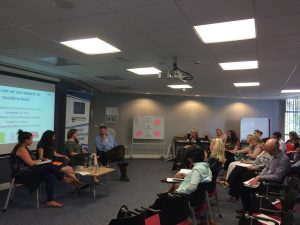Last month saw the first ESRC IAA and Creative Fuse CAKE collaboration over at the Mining Institute in Newcastle. Here Frances Hardcastle from Creative Fuse summarises the main points from the afternoon presentations.
How does the digital affect archive materials? Often when we consider digital archives, we equate this with the process of digitisation – creating a digital copy of an item that can be viewed on a screen and stored on a server. But what if there was more to the digital archive than digitisation? In our 15th Collaboration and Knowledge Exchange (CAKE) event, we explored the changing dynamics between digital and original artefacts, and how the message can complement and be transformed by the medium.
In keeping with our theme, this month’s event blended the grandeur and heritage of the venue with a 21st Century audience; filling the library of the Mining Institute with representatives from the region’s Creative, Digital and IT sector.
Fabulous venue for CAKE 15 at the @MiningInstitute, Newcastle. Hosted by @CreativeFuseNE, four speakers will be giving their thoughts on the impact of Digital Archives! #FuseCAKE #DigitalArchives pic.twitter.com/MWfbAFDKdl
— JUMP (@yousayjump) 25 January 2018
Our first speakers were from Animating Text at Newcastle University (ATNU). Professor Jennifer Richards and her colleagues, Professor Michael Rossington, Dr James Cummings and Dr Tiago Sousa Garcia gave a lightening fast introduction to the world of digital scholarly editing and the pioneering work taking place at Newcastle University.
The team explained that animating text is nothing to do with film animation, but instead explores how technology can enhance archive materials; creating a digital edition that is more than a simple digitisation of a text.
.@AnimatingTextNU work across humanities and computing sciences – brilliant example of creative fusion! #FuseCAKE
— CreativeFuseNE (@CreativeFuseNE) 25 January 2018
The team at ATNU is made up of researchers from disciplines as diverse as English Literature, Language and Linguistics, Arts and Cultures, Modern Languages, History, Classics and Archaeology, and Computer Science. Through this blend of perspectives, ATNU will explore how digital technology can produce different ways of understanding, explaining and experiencing a text; whilst also re-imagining the reading experience itself.
.@AnimatingTextNU is all about creating immersive experiences between text and reader. #FuseCAKE
— CreativeFuseNE (@CreativeFuseNE) 25 January 2018
Projects at ATNU can be generally aligned within three themes: Manuscript & Print, Performance, and Translation, and their new project “The Reading Sensorium” incorporates all three.
The Reading Sensorium – a large scale research project. How text on the page (or screen) already incorporates its own performance – or, more simply, how should we read it aloud? #FuseCAKE
— CreativeFuseNE (@CreativeFuseNE) 25 January 2018
ATNU want to develop a web-based platform where users can direct computers how to read particular texts, making them up to allow the computer to produce an expressive reading.
The Reading Sensorium’s main challenge? Robot speak; old texts, with old spellings, and limitations of SSML (Speech Synthesis Markup Language) There’s no instruction for irony, for example #FuseCAKE
— CreativeFuseNE (@CreativeFuseNE) 25 January 2018
Despite a few research and development challenges, the potential is truly massive for re-imagining our experiences with the written word.
Computers reading text with feeling. Amazon need to hear this #FuseCAKE
— andy frith (@seussmad) 25 January 2018
Our second speaker was Dr Jenna Ashton, Creative Director at Digital Women’s Archive North (DWAN). DWAN is a feminist arts and heritage organisation, based in the North West. They support women and girls to identify, collect, disseminate and celebrate their cultural heritage through creative and digital activities.
@dwarchivenorth now speaking about the role of digital archiving in the preserving, the promoting and the politics of feminism’s cultural heritage #FuseCake pic.twitter.com/RvKjNwCPJB
— Concision (@concision) 25 January 2018
Jenna spoke about the nature of digital archiving, and tackled some common misconceptions about these methods.
Misconceptions are rife as to the nature of digital methods in archives – not a replacement for physical items, a complementary system that audiences can interact with in a different way. #FuseCAKE
— CreativeFuseNE (@CreativeFuseNE) 25 January 2018
A digital archive is sometimes automatically considered as a tool through which expanded access and participation can be achieved. However, Jenna encouraged us to view this assumption with a degree of caution. Much like physical spaces, digital spaces are not necessarily inclusive or welcoming to all people.
How can digital spaces be truly participatory, and not a reflection of offline spheres that can exclude others? Jenna asks some brilliant questions at #FuseCAKE
— CreativeFuseNE (@CreativeFuseNE) 25 January 2018
Of course, these issues must be considered as part of any digital archiving project. Jenna asked us all to consider what kinds of spaces we wanted or needed online. As part of DWAN’s work, they take in “orphan collections” of archive materials that can not be housed elsewhere, illustrating Jenna’s point well. Through this, DWAN re-imagines digital spaces as a home for a diverse range of marginalised voices, which may have been excluded from other physical spaces.
Next up was Sue Bradley, Research Associate in Oral History, based at the Newcastle University Centre for Rural Economy.
Third speaker at #FuseCAKE talking about digital archives, oral history and the tools we need to be heard in a world that is getting louder #wordsmatter pic.twitter.com/33gn0CQ6WC
— Concision (@concision) 25 January 2018
As with Jenna’s presentation, Sue also embedded her work within the wider social and ethical contexts associated with digital archiving.
Using the example of her work collecting oral histories, Sue discussed how digital methods have been able to connect us more closely with those telling their stories – capturing and sharing the voices themselves as opposed to a written transcript of the conversation. However, along with new methods of recording and disseminating historical sources, comes new questions surrounding the usage of the material and new mechanisms needed to make sense of the volume of information:
Oral testimony is living testimony, when a recording is made, can we be prepared for it’s future life in an archive? How will its contents affect those who are left behind when the speaker is no longer around? Interesting ethical questions here #FuseCAKE
— CreativeFuseNE (@CreativeFuseNE) 25 January 2018
We record people’s history in real time with the likes of Twitter: bringing a massive surge of voices to the public sphere. This is where digital archives and oral history can come into their own – tools to make sense of all the voices are more vital than ever before #FuseCAKE
— CreativeFuseNE (@CreativeFuseNE) 25 January 2018
CAKE’s final speaker was artist and writer Stevie Ronnie. Stevie is an interdisciplinary artist with a background in computer science – another great example of the fruitful fusion of creative skills and technology expertise.
Stevie Ronnie, writer and artist, on how to combine tech and art #FuseCAKE
— ATNU (@AnimatingTextNU) 25 January 2018
Stevie discussed his creative approach, combining the traditional and the digital. One installation, Brass Book, challenged fears that technology will replace printed books. The exhibition featured traditionally bound books, embedded with technology. Visitors were invited to interact with both elements, and was very well received.
Linking back to @AnimatingTextNU , Stevie’s ideas consider the concept of digital books offering something more than being simply a digitised version of the paper copy. Beautifully illustrated by a book physically bound together by cables #FuseCAKE
— CreativeFuseNE (@CreativeFuseNE) 25 January 2018
Stevie’s creative practice explores the harmonies between books and technologies, pushing at the notion that “the book is more than just the text it contains.”
Q&A
With our four speakers throwing out plenty of exciting ideas in the realm of digital archiving, it was time to open the floor to questions and further discussion from our audience:
Q & A time – and stunned silence – all the amazing ideas still sinking in #FuseCAKE
— CreativeFuseNE (@CreativeFuseNE) 25 January 2018
Q: With oral narratives, how can one separate the history from the fiction?
A: In long term historical interests, some speakers can ask for sealed recordings – with no-holds barred narratives #FuseCAKE— CreativeFuseNE (@CreativeFuseNE) 25 January 2018
Q: How can we futureproof our digital archives? Remember minidiscs/Laserdiscs?
A: You can’t but recovery of data is possible. The book is a great example of futureproof tech! #FuseCAKE— CreativeFuseNE (@CreativeFuseNE) 25 January 2018
Q: The Lindisfarne Gospels were created over long period of time – how does the speed of digital methods affect the way we archive our heritage?
A: It can be good to slow down a little – think about what people value, what people might want to interact with #FuseCAKE— CreativeFuseNE (@CreativeFuseNE) 25 January 2018
Q: Interview design in oral histories – how much does a researcher allow a freeflow of a narrative vs getting to the hard questions?
A: Methodologies vary, in general the fewer questions, the better – getting on a roll can be rewarding #FuseCAKE— CreativeFuseNE (@CreativeFuseNE) 25 January 2018
Q: Are there areas of your work that would benefit from cross-sector collaboration?
A: Sue – show me your wishlists!
A: Jennifer: would love to hear ideas
A: Stevie: looking for a digital space to host a poem for 100 years
A: Jenna: gives homes to “orphan collections” #FuseCAKE— CreativeFuseNE (@CreativeFuseNE) 25 January 2018
With so many different perspectives and interests represented in the room, the networking session was bound to be interesting. At this point, the question on everyone’s mind was starting to turn to refreshment and fuel for the next stage:
When @CreativeFuseNE peeps say there’s cake at their collaboration and knowledge exchange event (CAKE) they don’t exaggerate…#fusecake pic.twitter.com/tQKtgBnDV1
— eve forrest (@eveforrest) 25 January 2018
In closing, CAKE 15: Digital Archives was a great introduction to activity and key issues within the field, raising many further questions for future exploration.
Thanks for the invite @CreativeFuseNE #FuseCAKE A fabulous room of ideas and discussion #feminist #digitalheritage #archives
— [DWAN] (@dwarchivenorth) 25 January 2018
This event was generously supported via Newcastle University by the Economic and Social Research Council (ESRC) Impact Acceleration Account.
External Links (recommended by Sue Bradley):
Sisterhood and After – oral history interviews featuring activists of the Women’s Liberation Movement.
Foundling Voices – memories of separation, schooling, love, loss and rediscovery from people who grew up in the care of a Foundling Hospital between 1912-54.
Newcastle University Special Collections – Various oral history collections
This post was first published on Creative Fuse Cake Mix blog


